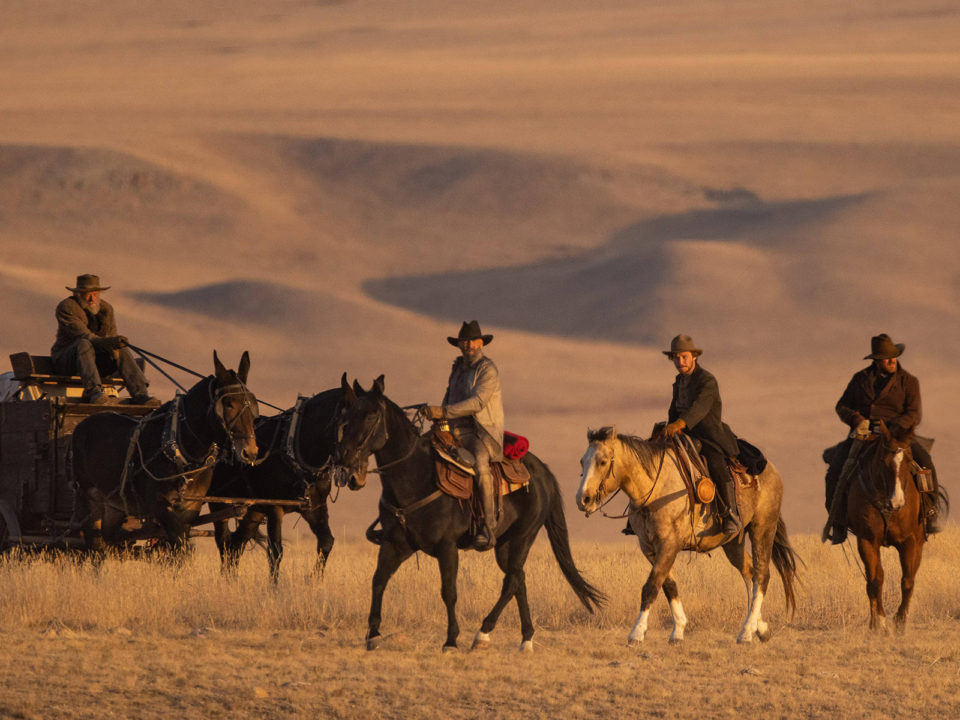The Local newsletter is your free, daily guide to life in Colorado. For locals, by locals. Sign up today!
Much has been written about the (re)settlement of the West. The wagon trains carrying families moving from the East Coast. The Gold Rush. The building of the railroad. The inhumane treatment of Native American tribes. Less scrutiny has been directed toward the impact these expeditions and new settlements had on the landscape and environment—including the free-roaming bison that have been so important to Indigenous communities throughout history.
Butcher’s Crossing, which was released on October 20, takes viewers back to 1874 to that overlooked history. Miller, played by Nicolas Cage, is a buffalo hunter who convinces an idealistic Harvard student named Will Andrews (Fred Hechinger) to fund an expedition from Kansas to Colorado to take down a massive herd. They’re joined by a skinner (Jeremy Bobb) and a cook (Xander Berkeley). The group’s planned trip ultimately becomes a test of endurance as Miller’s obsession with killing more animals, to make more money from their hides, keeps them at camp so long that winter rolls in, trapping them—and hundreds of buffalo they’d already slaughtered.
That's only $1 per issue!
Before heading to the theater, here are five things you should know about the film.
University of Denver Professor John Williams wrote the book on which the movie is based.
The film is an adaptation of the 1960 novel by the late author and DU creative writing professor Williams. The book was not widely read, despite being “not only a great story, but beautifully written,” says his daughter Pamela Williams, who was not involved in the making of the movie. “It was not a book necessarily about the slaughter of buffaloes, although that was certainly there. It was a book on masculinity, on obsession, on reckoning with what it means to grow up.” One of Williams’ later books, Augustus, won the National Book Award in 1973.
The story is fictional but (mostly) historically accurate.
In the early 19th century, somewhere between 30 and 50 million bison roamed the Great Plains. (Though the U.S. brethren of this species are called American bison, they’re often referred to as buffalo.) Then bison hides became a popular fashion item, and the animals were hunted to near extinction by frontiersmen eager to make a buck—until the wares fell out of fashion. By 1902, less than 100 wild bison remained. This threatened the livelihood of Indigenous tribes who relied on the animals for sustenance, warmth, and ceremonial purposes.
Careful viewers will note that the 1874 expedition is to Colorado—although Colorado didn’t become a state until 1876.
Director Gabe Polsky wrote the first draft of the screenplay in a Basalt library.
“I’ve been going to Colorado since I was a kid,” Polsky says. “It’s restorative. It’s epic. And just part of my soul.” Though he’s better known for his documentaries—including In Search of Greatness and Red Army—Polsky, 44, says his personal history with the Centennial State is what drew him to Williams’ story. “When I read the book, this idea of the character Will going out and trying to learn about the land and the country and find purpose and meaning, I kind of related to that,” he says.
The movie takes place in Colorado but wasn’t filmed in the Centennial State.

Astute filmgoers will notice that the movie’s setting is most definitely not Colorado. The grasses, the peaks, the grandeur—none are quite right. That’s because Butcher’s Crossing was filmed in Montana, on Blackfeet Nation land with animals from the tribe’s Blackfeet Buffalo Program, which maintains a herd of about 600 animals. Though they’re noticeably absent from the screen (and the book), tribal members helped herd the animals for filming and also educated the actors on how to properly skin them. Polsky says it was this direct access to buffalo that motivated his decision to film in Montana, along with the state’s financial incentives.
The bison are making a comeback thanks to tribal efforts.
Today, around 20,000 Plains bison roam in conservation herds, while there are another 420,000 in commercial herds, according to the U.S. Fish & Wildlife Service. Tribal governments have been critical in that resurgence. The Blackfeet Buffalo Program, for example, is part of the Intertribal Buffalo Council, which is committed to restoring bison to tribal lands. “We have a real spiritual connection to [bison]. We consider them our relatives,” says Ervin Carlson, Council president and director of the Blackfeet program. “There was a lot of trauma done to tribes. We’re always trying to heal from it. Buffalo are spiritual. They’re a big part of that, of helping us heal. And they’re good for the land.”
Butcher’s Crossing is showing at numerous Denver-area theaters. The movie will be available to rent or buy at home on November 7; streaming dates have not yet been released.







